Effects of Loneliness on Older Adults: A Case Study
VerifiedAdded on 2023/06/03
|8
|2373
|357
AI Summary
This essay discusses the effects of loneliness on older adults, with a case study of a woman who lost her husband and is facing various issues like loneliness. It also explores scientific research and theories related to ageing and associated issues.
Contribute Materials
Your contribution can guide someone’s learning journey. Share your
documents today.
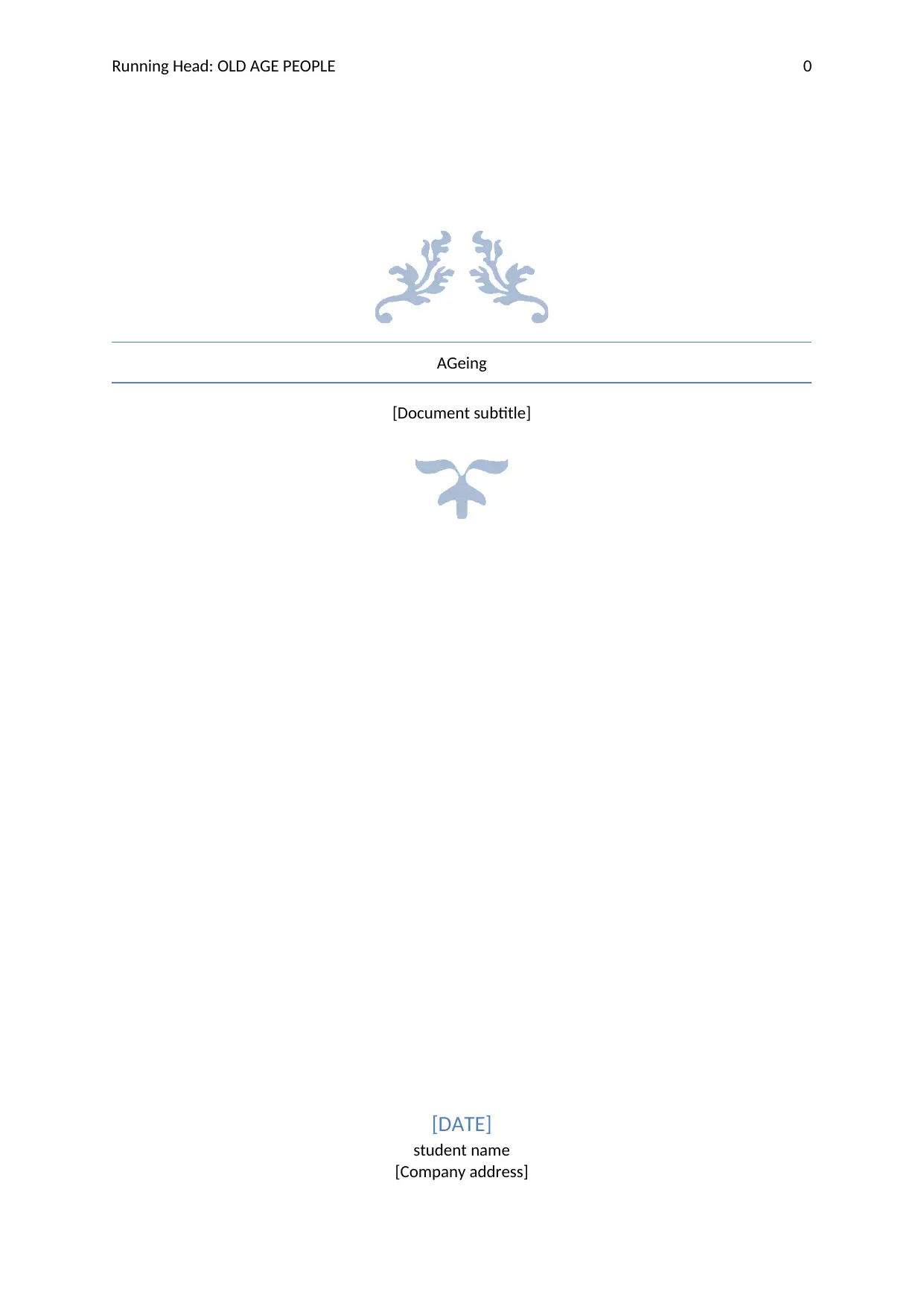
Running Head: OLD AGE PEOPLE 0
AGeing
[Document subtitle]
[DATE]
student name
[Company address]
AGeing
[Document subtitle]
[DATE]
student name
[Company address]
Secure Best Marks with AI Grader
Need help grading? Try our AI Grader for instant feedback on your assignments.
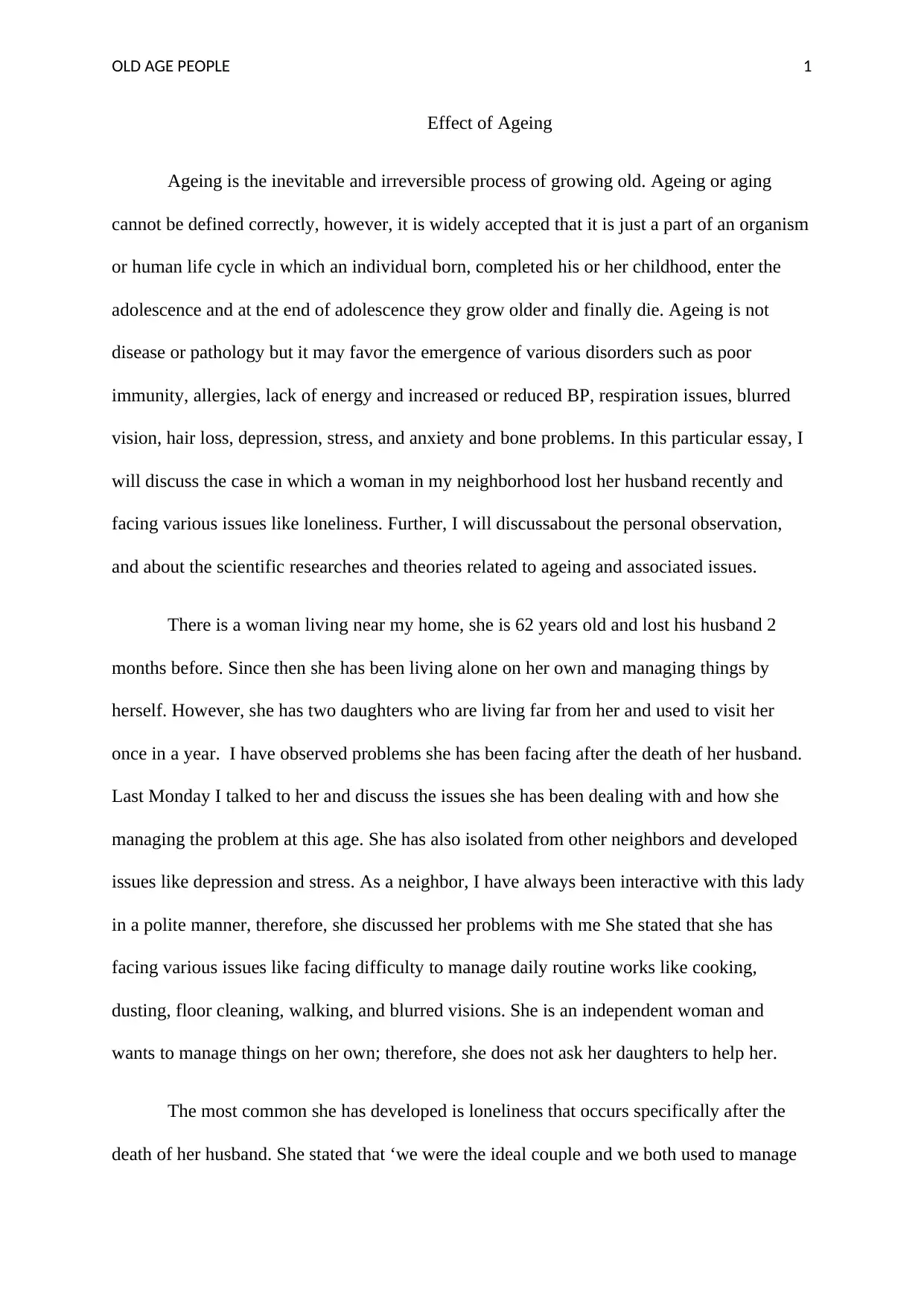
OLD AGE PEOPLE 1
Effect of Ageing
Ageing is the inevitable and irreversible process of growing old. Ageing or aging
cannot be defined correctly, however, it is widely accepted that it is just a part of an organism
or human life cycle in which an individual born, completed his or her childhood, enter the
adolescence and at the end of adolescence they grow older and finally die. Ageing is not
disease or pathology but it may favor the emergence of various disorders such as poor
immunity, allergies, lack of energy and increased or reduced BP, respiration issues, blurred
vision, hair loss, depression, stress, and anxiety and bone problems. In this particular essay, I
will discuss the case in which a woman in my neighborhood lost her husband recently and
facing various issues like loneliness. Further, I will discussabout the personal observation,
and about the scientific researches and theories related to ageing and associated issues.
There is a woman living near my home, she is 62 years old and lost his husband 2
months before. Since then she has been living alone on her own and managing things by
herself. However, she has two daughters who are living far from her and used to visit her
once in a year. I have observed problems she has been facing after the death of her husband.
Last Monday I talked to her and discuss the issues she has been dealing with and how she
managing the problem at this age. She has also isolated from other neighbors and developed
issues like depression and stress. As a neighbor, I have always been interactive with this lady
in a polite manner, therefore, she discussed her problems with me She stated that she has
facing various issues like facing difficulty to manage daily routine works like cooking,
dusting, floor cleaning, walking, and blurred visions. She is an independent woman and
wants to manage things on her own; therefore, she does not ask her daughters to help her.
The most common she has developed is loneliness that occurs specifically after the
death of her husband. She stated that ‘we were the ideal couple and we both used to manage
Effect of Ageing
Ageing is the inevitable and irreversible process of growing old. Ageing or aging
cannot be defined correctly, however, it is widely accepted that it is just a part of an organism
or human life cycle in which an individual born, completed his or her childhood, enter the
adolescence and at the end of adolescence they grow older and finally die. Ageing is not
disease or pathology but it may favor the emergence of various disorders such as poor
immunity, allergies, lack of energy and increased or reduced BP, respiration issues, blurred
vision, hair loss, depression, stress, and anxiety and bone problems. In this particular essay, I
will discuss the case in which a woman in my neighborhood lost her husband recently and
facing various issues like loneliness. Further, I will discussabout the personal observation,
and about the scientific researches and theories related to ageing and associated issues.
There is a woman living near my home, she is 62 years old and lost his husband 2
months before. Since then she has been living alone on her own and managing things by
herself. However, she has two daughters who are living far from her and used to visit her
once in a year. I have observed problems she has been facing after the death of her husband.
Last Monday I talked to her and discuss the issues she has been dealing with and how she
managing the problem at this age. She has also isolated from other neighbors and developed
issues like depression and stress. As a neighbor, I have always been interactive with this lady
in a polite manner, therefore, she discussed her problems with me She stated that she has
facing various issues like facing difficulty to manage daily routine works like cooking,
dusting, floor cleaning, walking, and blurred visions. She is an independent woman and
wants to manage things on her own; therefore, she does not ask her daughters to help her.
The most common she has developed is loneliness that occurs specifically after the
death of her husband. She stated that ‘we were the ideal couple and we both used to manage
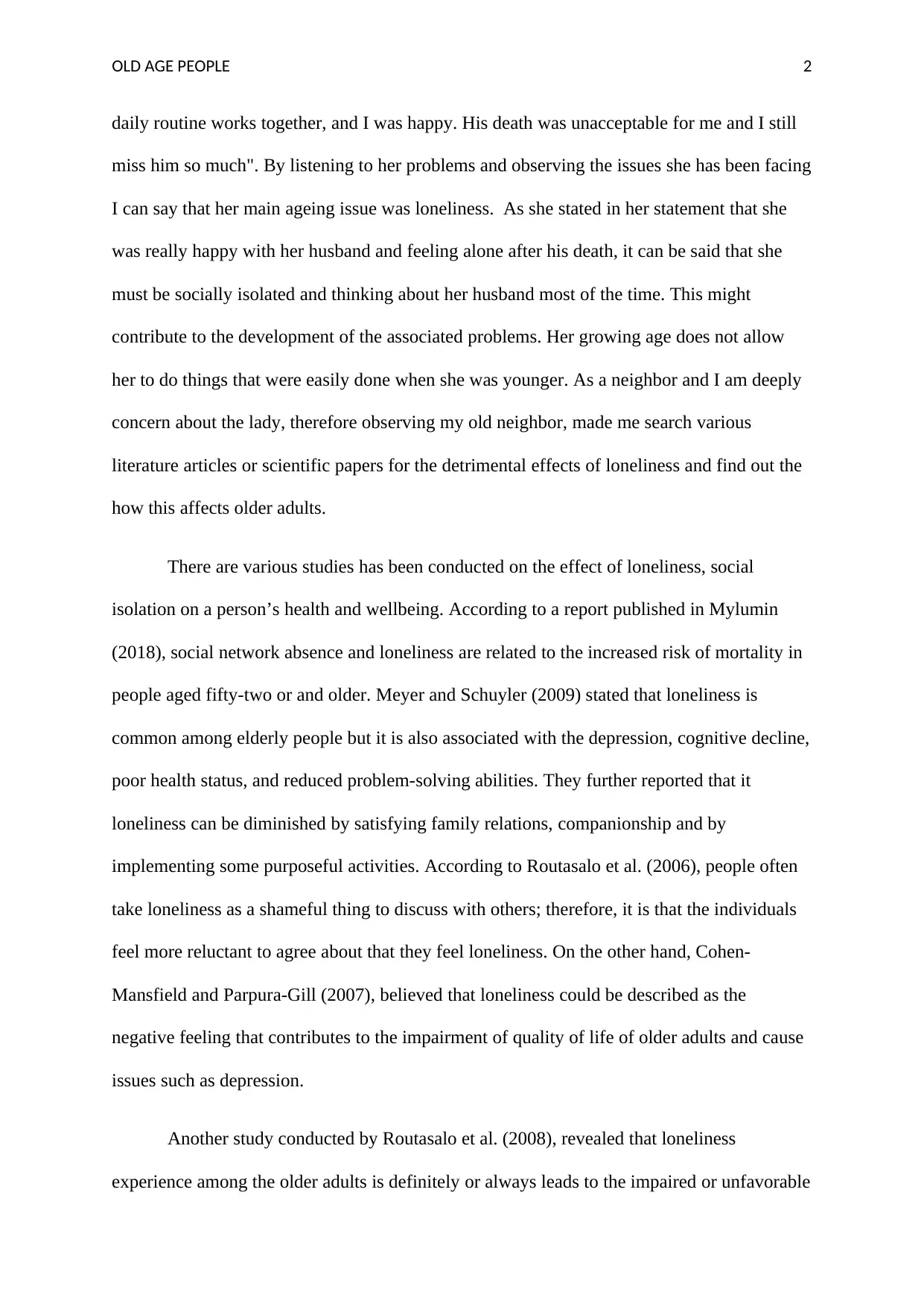
OLD AGE PEOPLE 2
daily routine works together, and I was happy. His death was unacceptable for me and I still
miss him so much". By listening to her problems and observing the issues she has been facing
I can say that her main ageing issue was loneliness. As she stated in her statement that she
was really happy with her husband and feeling alone after his death, it can be said that she
must be socially isolated and thinking about her husband most of the time. This might
contribute to the development of the associated problems. Her growing age does not allow
her to do things that were easily done when she was younger. As a neighbor and I am deeply
concern about the lady, therefore observing my old neighbor, made me search various
literature articles or scientific papers for the detrimental effects of loneliness and find out the
how this affects older adults.
There are various studies has been conducted on the effect of loneliness, social
isolation on a person’s health and wellbeing. According to a report published in Mylumin
(2018), social network absence and loneliness are related to the increased risk of mortality in
people aged fifty-two or and older. Meyer and Schuyler (2009) stated that loneliness is
common among elderly people but it is also associated with the depression, cognitive decline,
poor health status, and reduced problem-solving abilities. They further reported that it
loneliness can be diminished by satisfying family relations, companionship and by
implementing some purposeful activities. According to Routasalo et al. (2006), people often
take loneliness as a shameful thing to discuss with others; therefore, it is that the individuals
feel more reluctant to agree about that they feel loneliness. On the other hand, Cohen-
Mansfield and Parpura-Gill (2007), believed that loneliness could be described as the
negative feeling that contributes to the impairment of quality of life of older adults and cause
issues such as depression.
Another study conducted by Routasalo et al. (2008), revealed that loneliness
experience among the older adults is definitely or always leads to the impaired or unfavorable
daily routine works together, and I was happy. His death was unacceptable for me and I still
miss him so much". By listening to her problems and observing the issues she has been facing
I can say that her main ageing issue was loneliness. As she stated in her statement that she
was really happy with her husband and feeling alone after his death, it can be said that she
must be socially isolated and thinking about her husband most of the time. This might
contribute to the development of the associated problems. Her growing age does not allow
her to do things that were easily done when she was younger. As a neighbor and I am deeply
concern about the lady, therefore observing my old neighbor, made me search various
literature articles or scientific papers for the detrimental effects of loneliness and find out the
how this affects older adults.
There are various studies has been conducted on the effect of loneliness, social
isolation on a person’s health and wellbeing. According to a report published in Mylumin
(2018), social network absence and loneliness are related to the increased risk of mortality in
people aged fifty-two or and older. Meyer and Schuyler (2009) stated that loneliness is
common among elderly people but it is also associated with the depression, cognitive decline,
poor health status, and reduced problem-solving abilities. They further reported that it
loneliness can be diminished by satisfying family relations, companionship and by
implementing some purposeful activities. According to Routasalo et al. (2006), people often
take loneliness as a shameful thing to discuss with others; therefore, it is that the individuals
feel more reluctant to agree about that they feel loneliness. On the other hand, Cohen-
Mansfield and Parpura-Gill (2007), believed that loneliness could be described as the
negative feeling that contributes to the impairment of quality of life of older adults and cause
issues such as depression.
Another study conducted by Routasalo et al. (2008), revealed that loneliness
experience among the older adults is definitely or always leads to the impaired or unfavorable
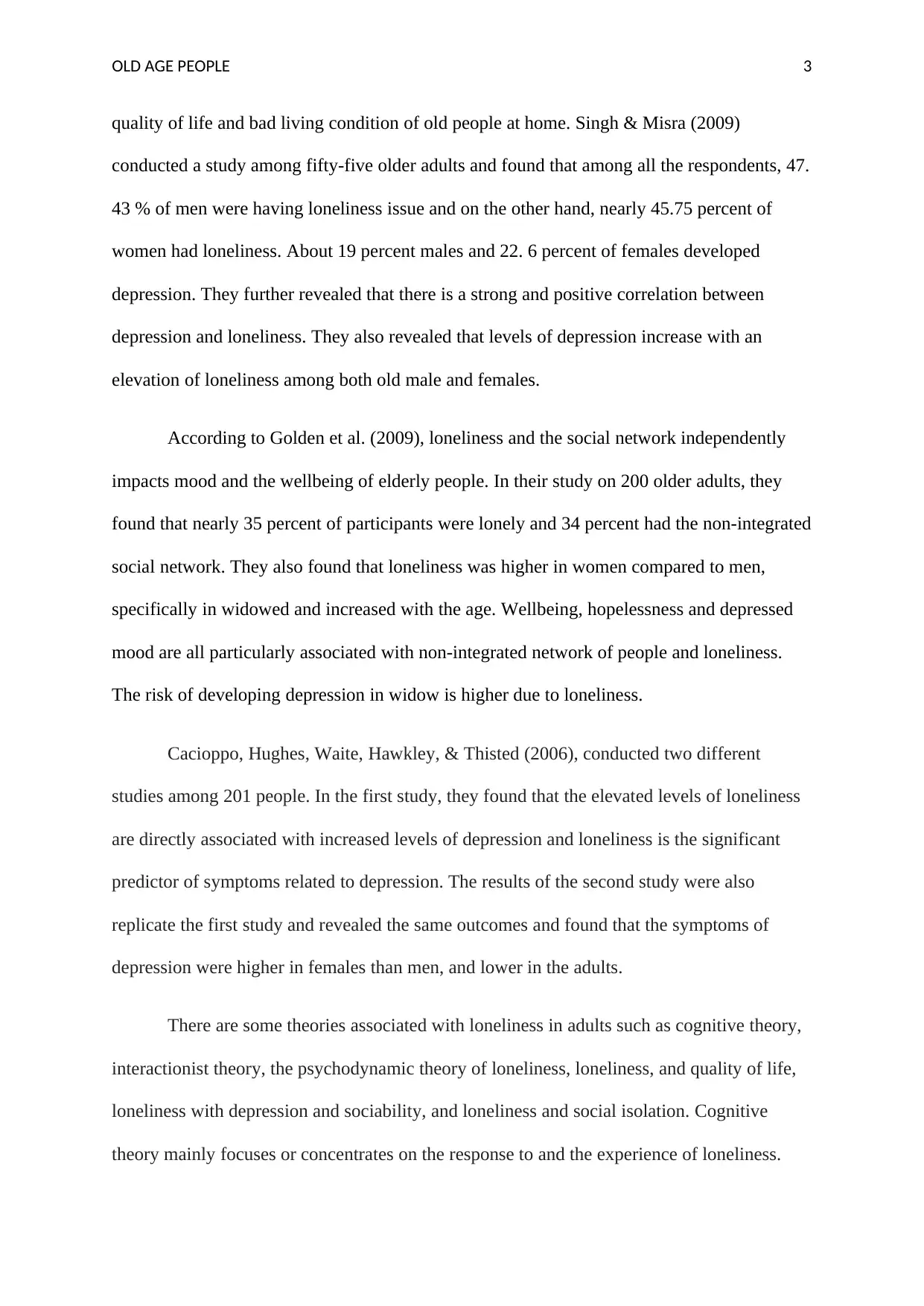
OLD AGE PEOPLE 3
quality of life and bad living condition of old people at home. Singh & Misra (2009)
conducted a study among fifty-five older adults and found that among all the respondents, 47.
43 % of men were having loneliness issue and on the other hand, nearly 45.75 percent of
women had loneliness. About 19 percent males and 22. 6 percent of females developed
depression. They further revealed that there is a strong and positive correlation between
depression and loneliness. They also revealed that levels of depression increase with an
elevation of loneliness among both old male and females.
According to Golden et al. (2009), loneliness and the social network independently
impacts mood and the wellbeing of elderly people. In their study on 200 older adults, they
found that nearly 35 percent of participants were lonely and 34 percent had the non-integrated
social network. They also found that loneliness was higher in women compared to men,
specifically in widowed and increased with the age. Wellbeing, hopelessness and depressed
mood are all particularly associated with non-integrated network of people and loneliness.
The risk of developing depression in widow is higher due to loneliness.
Cacioppo, Hughes, Waite, Hawkley, & Thisted (2006), conducted two different
studies among 201 people. In the first study, they found that the elevated levels of loneliness
are directly associated with increased levels of depression and loneliness is the significant
predictor of symptoms related to depression. The results of the second study were also
replicate the first study and revealed the same outcomes and found that the symptoms of
depression were higher in females than men, and lower in the adults.
There are some theories associated with loneliness in adults such as cognitive theory,
interactionist theory, the psychodynamic theory of loneliness, loneliness, and quality of life,
loneliness with depression and sociability, and loneliness and social isolation. Cognitive
theory mainly focuses or concentrates on the response to and the experience of loneliness.
quality of life and bad living condition of old people at home. Singh & Misra (2009)
conducted a study among fifty-five older adults and found that among all the respondents, 47.
43 % of men were having loneliness issue and on the other hand, nearly 45.75 percent of
women had loneliness. About 19 percent males and 22. 6 percent of females developed
depression. They further revealed that there is a strong and positive correlation between
depression and loneliness. They also revealed that levels of depression increase with an
elevation of loneliness among both old male and females.
According to Golden et al. (2009), loneliness and the social network independently
impacts mood and the wellbeing of elderly people. In their study on 200 older adults, they
found that nearly 35 percent of participants were lonely and 34 percent had the non-integrated
social network. They also found that loneliness was higher in women compared to men,
specifically in widowed and increased with the age. Wellbeing, hopelessness and depressed
mood are all particularly associated with non-integrated network of people and loneliness.
The risk of developing depression in widow is higher due to loneliness.
Cacioppo, Hughes, Waite, Hawkley, & Thisted (2006), conducted two different
studies among 201 people. In the first study, they found that the elevated levels of loneliness
are directly associated with increased levels of depression and loneliness is the significant
predictor of symptoms related to depression. The results of the second study were also
replicate the first study and revealed the same outcomes and found that the symptoms of
depression were higher in females than men, and lower in the adults.
There are some theories associated with loneliness in adults such as cognitive theory,
interactionist theory, the psychodynamic theory of loneliness, loneliness, and quality of life,
loneliness with depression and sociability, and loneliness and social isolation. Cognitive
theory mainly focuses or concentrates on the response to and the experience of loneliness.
Secure Best Marks with AI Grader
Need help grading? Try our AI Grader for instant feedback on your assignments.
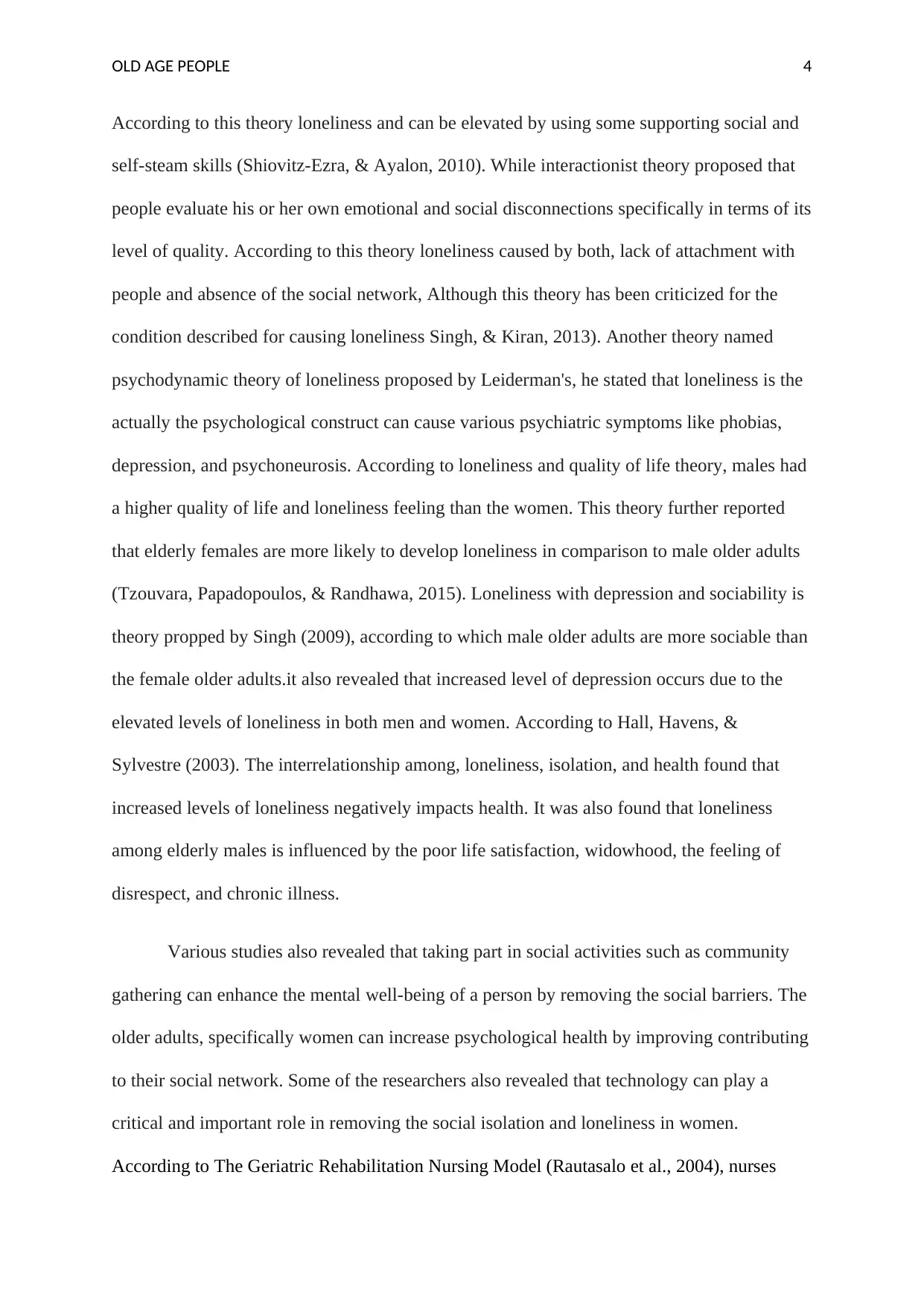
OLD AGE PEOPLE 4
According to this theory loneliness and can be elevated by using some supporting social and
self-steam skills (Shiovitz-Ezra, & Ayalon, 2010). While interactionist theory proposed that
people evaluate his or her own emotional and social disconnections specifically in terms of its
level of quality. According to this theory loneliness caused by both, lack of attachment with
people and absence of the social network, Although this theory has been criticized for the
condition described for causing loneliness Singh, & Kiran, 2013). Another theory named
psychodynamic theory of loneliness proposed by Leiderman's, he stated that loneliness is the
actually the psychological construct can cause various psychiatric symptoms like phobias,
depression, and psychoneurosis. According to loneliness and quality of life theory, males had
a higher quality of life and loneliness feeling than the women. This theory further reported
that elderly females are more likely to develop loneliness in comparison to male older adults
(Tzouvara, Papadopoulos, & Randhawa, 2015). Loneliness with depression and sociability is
theory propped by Singh (2009), according to which male older adults are more sociable than
the female older adults.it also revealed that increased level of depression occurs due to the
elevated levels of loneliness in both men and women. According to Hall, Havens, &
Sylvestre (2003). The interrelationship among, loneliness, isolation, and health found that
increased levels of loneliness negatively impacts health. It was also found that loneliness
among elderly males is influenced by the poor life satisfaction, widowhood, the feeling of
disrespect, and chronic illness.
Various studies also revealed that taking part in social activities such as community
gathering can enhance the mental well-being of a person by removing the social barriers. The
older adults, specifically women can increase psychological health by improving contributing
to their social network. Some of the researchers also revealed that technology can play a
critical and important role in removing the social isolation and loneliness in women.
According to The Geriatric Rehabilitation Nursing Model (Rautasalo et al., 2004), nurses
According to this theory loneliness and can be elevated by using some supporting social and
self-steam skills (Shiovitz-Ezra, & Ayalon, 2010). While interactionist theory proposed that
people evaluate his or her own emotional and social disconnections specifically in terms of its
level of quality. According to this theory loneliness caused by both, lack of attachment with
people and absence of the social network, Although this theory has been criticized for the
condition described for causing loneliness Singh, & Kiran, 2013). Another theory named
psychodynamic theory of loneliness proposed by Leiderman's, he stated that loneliness is the
actually the psychological construct can cause various psychiatric symptoms like phobias,
depression, and psychoneurosis. According to loneliness and quality of life theory, males had
a higher quality of life and loneliness feeling than the women. This theory further reported
that elderly females are more likely to develop loneliness in comparison to male older adults
(Tzouvara, Papadopoulos, & Randhawa, 2015). Loneliness with depression and sociability is
theory propped by Singh (2009), according to which male older adults are more sociable than
the female older adults.it also revealed that increased level of depression occurs due to the
elevated levels of loneliness in both men and women. According to Hall, Havens, &
Sylvestre (2003). The interrelationship among, loneliness, isolation, and health found that
increased levels of loneliness negatively impacts health. It was also found that loneliness
among elderly males is influenced by the poor life satisfaction, widowhood, the feeling of
disrespect, and chronic illness.
Various studies also revealed that taking part in social activities such as community
gathering can enhance the mental well-being of a person by removing the social barriers. The
older adults, specifically women can increase psychological health by improving contributing
to their social network. Some of the researchers also revealed that technology can play a
critical and important role in removing the social isolation and loneliness in women.
According to The Geriatric Rehabilitation Nursing Model (Rautasalo et al., 2004), nurses
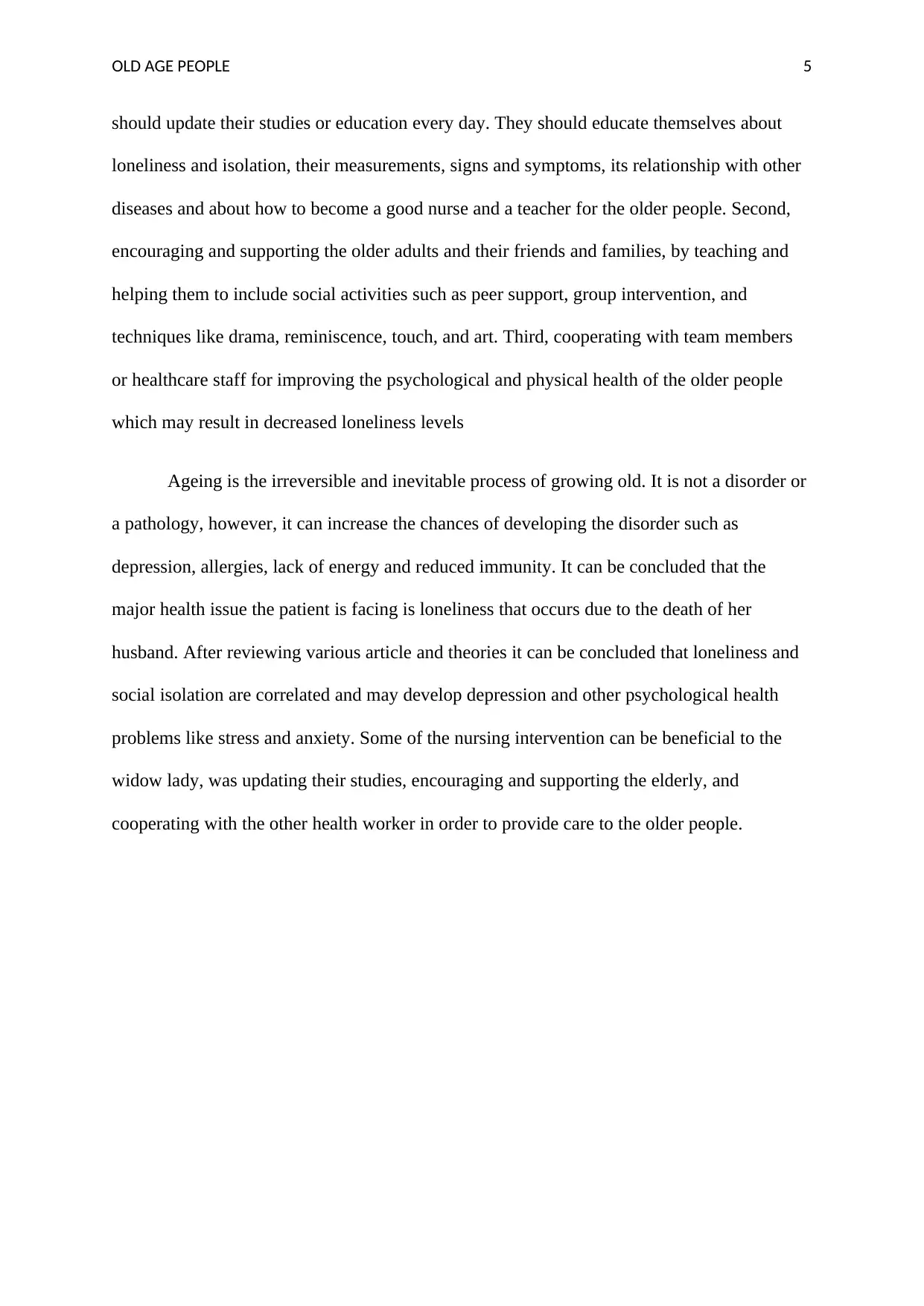
OLD AGE PEOPLE 5
should update their studies or education every day. They should educate themselves about
loneliness and isolation, their measurements, signs and symptoms, its relationship with other
diseases and about how to become a good nurse and a teacher for the older people. Second,
encouraging and supporting the older adults and their friends and families, by teaching and
helping them to include social activities such as peer support, group intervention, and
techniques like drama, reminiscence, touch, and art. Third, cooperating with team members
or healthcare staff for improving the psychological and physical health of the older people
which may result in decreased loneliness levels
Ageing is the irreversible and inevitable process of growing old. It is not a disorder or
a pathology, however, it can increase the chances of developing the disorder such as
depression, allergies, lack of energy and reduced immunity. It can be concluded that the
major health issue the patient is facing is loneliness that occurs due to the death of her
husband. After reviewing various article and theories it can be concluded that loneliness and
social isolation are correlated and may develop depression and other psychological health
problems like stress and anxiety. Some of the nursing intervention can be beneficial to the
widow lady, was updating their studies, encouraging and supporting the elderly, and
cooperating with the other health worker in order to provide care to the older people.
should update their studies or education every day. They should educate themselves about
loneliness and isolation, their measurements, signs and symptoms, its relationship with other
diseases and about how to become a good nurse and a teacher for the older people. Second,
encouraging and supporting the older adults and their friends and families, by teaching and
helping them to include social activities such as peer support, group intervention, and
techniques like drama, reminiscence, touch, and art. Third, cooperating with team members
or healthcare staff for improving the psychological and physical health of the older people
which may result in decreased loneliness levels
Ageing is the irreversible and inevitable process of growing old. It is not a disorder or
a pathology, however, it can increase the chances of developing the disorder such as
depression, allergies, lack of energy and reduced immunity. It can be concluded that the
major health issue the patient is facing is loneliness that occurs due to the death of her
husband. After reviewing various article and theories it can be concluded that loneliness and
social isolation are correlated and may develop depression and other psychological health
problems like stress and anxiety. Some of the nursing intervention can be beneficial to the
widow lady, was updating their studies, encouraging and supporting the elderly, and
cooperating with the other health worker in order to provide care to the older people.
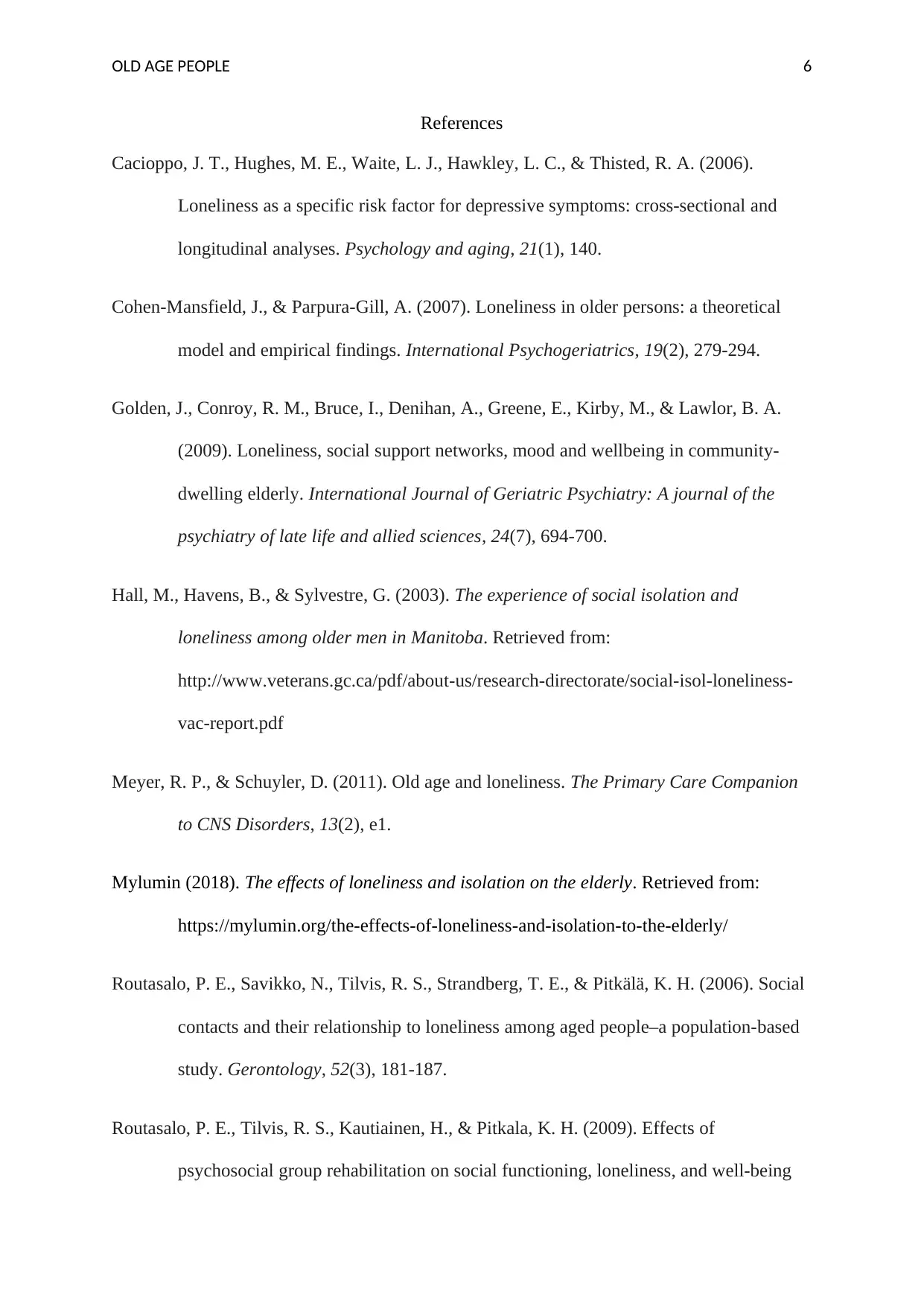
OLD AGE PEOPLE 6
References
Cacioppo, J. T., Hughes, M. E., Waite, L. J., Hawkley, L. C., & Thisted, R. A. (2006).
Loneliness as a specific risk factor for depressive symptoms: cross-sectional and
longitudinal analyses. Psychology and aging, 21(1), 140.
Cohen-Mansfield, J., & Parpura-Gill, A. (2007). Loneliness in older persons: a theoretical
model and empirical findings. International Psychogeriatrics, 19(2), 279-294.
Golden, J., Conroy, R. M., Bruce, I., Denihan, A., Greene, E., Kirby, M., & Lawlor, B. A.
(2009). Loneliness, social support networks, mood and wellbeing in community‐
dwelling elderly. International Journal of Geriatric Psychiatry: A journal of the
psychiatry of late life and allied sciences, 24(7), 694-700.
Hall, M., Havens, B., & Sylvestre, G. (2003). The experience of social isolation and
loneliness among older men in Manitoba. Retrieved from:
http://www.veterans.gc.ca/pdf/about-us/research-directorate/social-isol-loneliness-
vac-report.pdf
Meyer, R. P., & Schuyler, D. (2011). Old age and loneliness. The Primary Care Companion
to CNS Disorders, 13(2), e1.
Mylumin (2018). The effects of loneliness and isolation on the elderly. Retrieved from:
https://mylumin.org/the-effects-of-loneliness-and-isolation-to-the-elderly/
Routasalo, P. E., Savikko, N., Tilvis, R. S., Strandberg, T. E., & Pitkälä, K. H. (2006). Social
contacts and their relationship to loneliness among aged people–a population-based
study. Gerontology, 52(3), 181-187.
Routasalo, P. E., Tilvis, R. S., Kautiainen, H., & Pitkala, K. H. (2009). Effects of
psychosocial group rehabilitation on social functioning, loneliness, and well‐being
References
Cacioppo, J. T., Hughes, M. E., Waite, L. J., Hawkley, L. C., & Thisted, R. A. (2006).
Loneliness as a specific risk factor for depressive symptoms: cross-sectional and
longitudinal analyses. Psychology and aging, 21(1), 140.
Cohen-Mansfield, J., & Parpura-Gill, A. (2007). Loneliness in older persons: a theoretical
model and empirical findings. International Psychogeriatrics, 19(2), 279-294.
Golden, J., Conroy, R. M., Bruce, I., Denihan, A., Greene, E., Kirby, M., & Lawlor, B. A.
(2009). Loneliness, social support networks, mood and wellbeing in community‐
dwelling elderly. International Journal of Geriatric Psychiatry: A journal of the
psychiatry of late life and allied sciences, 24(7), 694-700.
Hall, M., Havens, B., & Sylvestre, G. (2003). The experience of social isolation and
loneliness among older men in Manitoba. Retrieved from:
http://www.veterans.gc.ca/pdf/about-us/research-directorate/social-isol-loneliness-
vac-report.pdf
Meyer, R. P., & Schuyler, D. (2011). Old age and loneliness. The Primary Care Companion
to CNS Disorders, 13(2), e1.
Mylumin (2018). The effects of loneliness and isolation on the elderly. Retrieved from:
https://mylumin.org/the-effects-of-loneliness-and-isolation-to-the-elderly/
Routasalo, P. E., Savikko, N., Tilvis, R. S., Strandberg, T. E., & Pitkälä, K. H. (2006). Social
contacts and their relationship to loneliness among aged people–a population-based
study. Gerontology, 52(3), 181-187.
Routasalo, P. E., Tilvis, R. S., Kautiainen, H., & Pitkala, K. H. (2009). Effects of
psychosocial group rehabilitation on social functioning, loneliness, and well‐being
Paraphrase This Document
Need a fresh take? Get an instant paraphrase of this document with our AI Paraphraser
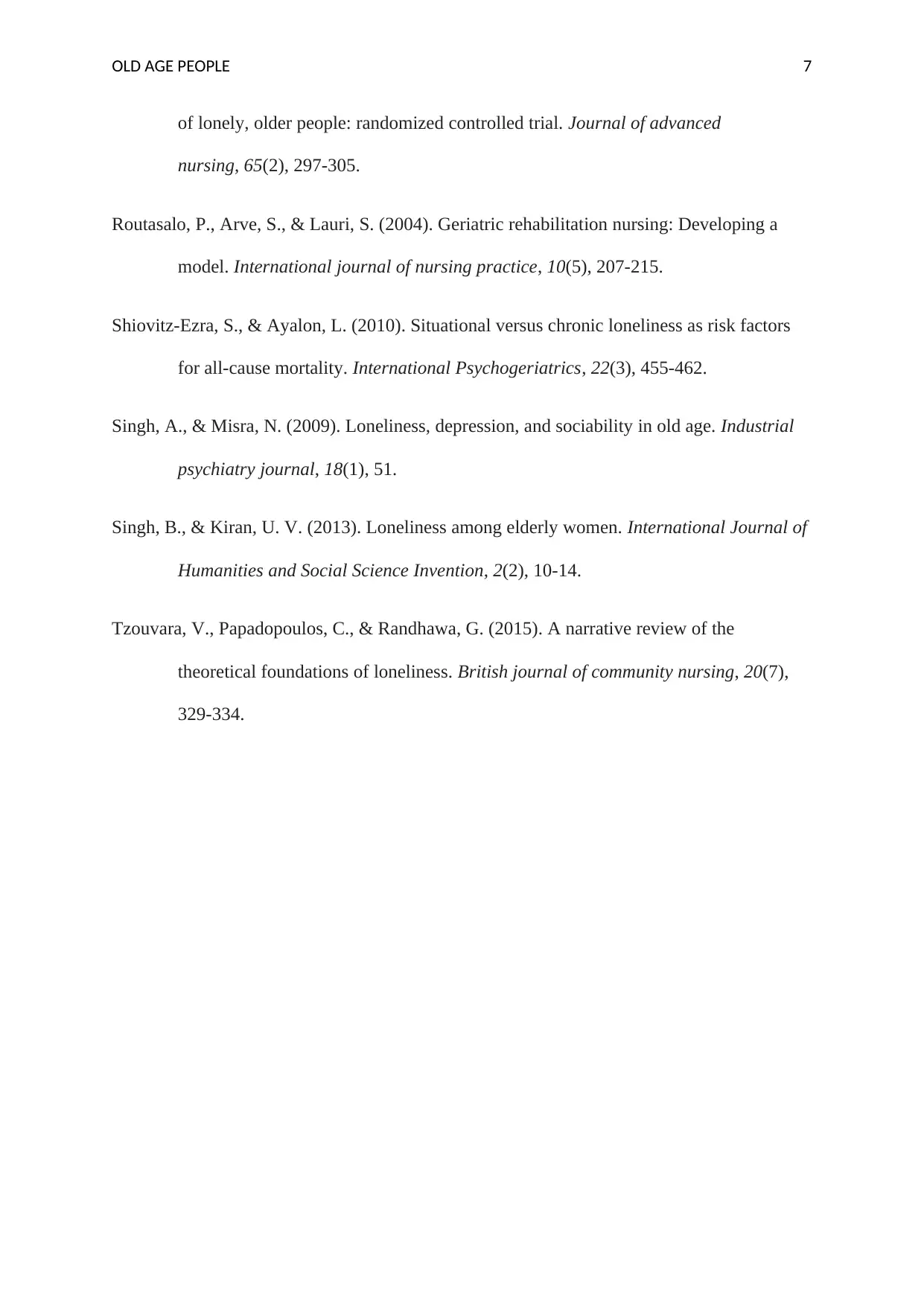
OLD AGE PEOPLE 7
of lonely, older people: randomized controlled trial. Journal of advanced
nursing, 65(2), 297-305.
Routasalo, P., Arve, S., & Lauri, S. (2004). Geriatric rehabilitation nursing: Developing a
model. International journal of nursing practice, 10(5), 207-215.
Shiovitz-Ezra, S., & Ayalon, L. (2010). Situational versus chronic loneliness as risk factors
for all-cause mortality. International Psychogeriatrics, 22(3), 455-462.
Singh, A., & Misra, N. (2009). Loneliness, depression, and sociability in old age. Industrial
psychiatry journal, 18(1), 51.
Singh, B., & Kiran, U. V. (2013). Loneliness among elderly women. International Journal of
Humanities and Social Science Invention, 2(2), 10-14.
Tzouvara, V., Papadopoulos, C., & Randhawa, G. (2015). A narrative review of the
theoretical foundations of loneliness. British journal of community nursing, 20(7),
329-334.
of lonely, older people: randomized controlled trial. Journal of advanced
nursing, 65(2), 297-305.
Routasalo, P., Arve, S., & Lauri, S. (2004). Geriatric rehabilitation nursing: Developing a
model. International journal of nursing practice, 10(5), 207-215.
Shiovitz-Ezra, S., & Ayalon, L. (2010). Situational versus chronic loneliness as risk factors
for all-cause mortality. International Psychogeriatrics, 22(3), 455-462.
Singh, A., & Misra, N. (2009). Loneliness, depression, and sociability in old age. Industrial
psychiatry journal, 18(1), 51.
Singh, B., & Kiran, U. V. (2013). Loneliness among elderly women. International Journal of
Humanities and Social Science Invention, 2(2), 10-14.
Tzouvara, V., Papadopoulos, C., & Randhawa, G. (2015). A narrative review of the
theoretical foundations of loneliness. British journal of community nursing, 20(7),
329-334.
1 out of 8
Related Documents
Your All-in-One AI-Powered Toolkit for Academic Success.
+13062052269
info@desklib.com
Available 24*7 on WhatsApp / Email
![[object Object]](/_next/static/media/star-bottom.7253800d.svg)
Unlock your academic potential
© 2024 | Zucol Services PVT LTD | All rights reserved.





